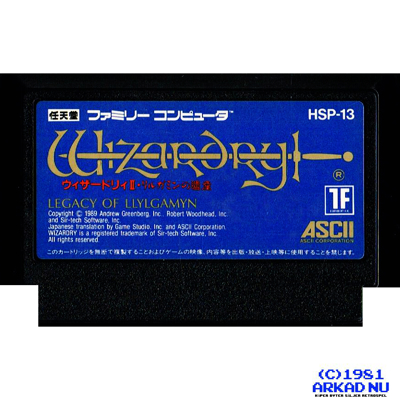WIZARDRY III LEGACY OF LLYLGAMYN FAMICOM
WIZARDRY III LEGACY OF LLYLGAMYN FAMICOM - HSP-13 - SPELET ÄR PÅ ENGELSKA ELLER JAPANSKA
FUNGERAR PÅ JAPANSK ELLER REGIONSFRI ENHET
Wizardry III: Legacy of Llylgamyn (originally known as Wizardry: Legacy of Llylgamyn - The Third Scenario) is the third scenario in the Wizardry series of role-playing video games. It was published in 1983 by Sir-Tech Software, Inc.
The City of Llylgamyn is threatened by the violent forces of nature. Earthquakes and volcanic rumblings endanger everyone. Only by seeking the dragon L'Kbreth can the city be saved.
Legacy of Llylgamyn is another six level dungeon crawl, although the dungeon is a volcano so the party journeys upwards rather than downwards. The gameplay and the spells are identical to the first two scenarios. Parties of up to six characters could adventure at one time.
Characters had to be imported from either Wizardry: Proving Grounds of the Mad Overlord or Wizardry II: The Knight of Diamonds. However, since the game was set years later, the characters were actually the descendants of the original characters. They kept the same name and class, could select a new alignment (class permitting), and were reset to level one.
Alignment was made more significant—certain areas of the game were accessible only to appropriately aligned (good or evil) parties. The first level was accessible to all parties, good, neutral or evil. (Note that evil and good characters are unwilling to adventure together, so a party is always either good [at least one good character, the rest neutral], evil [at least one evil character, the rest neutral] or neutral [all characters are neutral].) The second and fourth levels could only be accessed by parties with no evil characters—good or neutral parties. The third and fifth levels could only be accessed by parties with no good characters—evil or neutral parties. The sixth level could only be accessed by a party with at least one good or one evil character—no neutral parties. Neutral characters could travel into all areas but the last level, so theoretically you could get through most of the game with a party where all six characters were neutral. But practically speaking players were forced to build up more than 6 characters, as no party could function long term without a Cleric (good or evil), Wizard (good or evil) or Lord (good) for healing. This had the effect of prolonging gameplay.
ENDAST KASSETT

